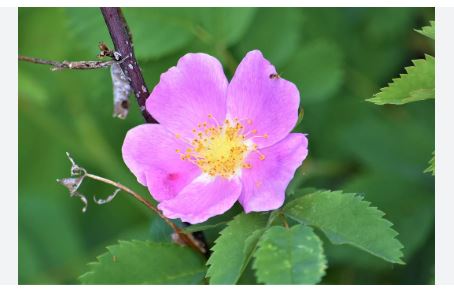
Rosa arkansana, commonly known as the Wild Prairie Rose or Arkansas Rose, is part of the Rosa genus within the Rosaceae family, which includes a wide variety of plants like roses, apples, and strawberries. This species is characterized by its small, pink flowers and its ability to form dense, thorny thickets. The species name “arkansana” refers to its collection from areas around the Arkansas River.
The Wild Prairie Rose is native to North America, with its range spanning from Alberta, Manitoba, and Saskatchewan in Canada, south through the Great Plains states including Montana, North Dakota, South Dakota, Nebraska, Kansas, Oklahoma, and into Texas, Arkansas, and Missouri. It thrives in prairies, open woodlands, and along roadsides, preferring well-drained soils in full sun to partial shade.
Historically, Rosa arkansana has been significant for both Native American tribes and early settlers. Indigenous peoples used its hips (fruits) for food and medicine, with the plant’s parts employed for treatments ranging from digestive issues to skin conditions. Settlers valued it for similar medicinal uses and as an ornamental due to its hardiness and beauty. It’s the state flower of both Iowa and North Dakota, reflecting its cultural importance in the Midwest. The Wild Prairie Rose symbolizes resilience and beauty in harsh conditions, often celebrated in local folklore and art.
Wild Prairie Rose is suited to USDA Hardiness Zones 3 through 8, showing its adaptability to both the cold winters of the northern plains and the warmer conditions further south. Its lifespan can be quite variable, often living for decades as a shrub, with some specimens potentially reaching over 50 years in ideal conditions. Its longevity is aided by its ability to spread through suckers and its resilience to environmental stresses like drought and cold.
Wild Prairie Rose (Rosa arkansana ): Characteristics
- Flower Appearance: Bears small, five-petaled, pink flowers that are about 1 to 2 inches in diameter. The flowers have a sweet, mild fragrance and are typically solitary but can occasionally form small clusters.
- Bloom Time: Blooms in late spring to early summer, with some potential for sporadic blooms later in the season, offering a colorful display on the prairies.
- Growth Habit: Grows as a deciduous shrub forming dense thickets due to its suckering habit. It reaches heights of 2 to 4 feet, with a spread that can be wider, creating a low, sprawling habit.
- Leaves: Leaves are compound, pinnate with 5 to 9 leaflets, each leaflet being oval to elliptic with toothed edges. They are typically a bright green, turning to yellow or red in the fall.
- Thorns: Features numerous, sharp, and straight thorns along its stems, which provide protection but also make handling challenging.
- Root System: Has an extensive root system with suckering capabilities, allowing it to spread and form colonies, which aids in soil stabilization and erosion control.
- Adaptability: Highly adaptable to various soil types but prefers well-drained, loamy soils. It tolerates both full sun and partial shade, showing resilience in the harsh conditions of the Great Plains.
- Fruit: Produces small, red, berry-like hips that persist into winter, providing food for wildlife and adding ornamental value to the landscape.
- Pollinator Attraction: Attracts bees, butterflies, and other pollinators with its nectar, playing a role in local ecosystems by supporting biodiversity.
- Ecological Role: Serves as an important plant in prairie ecosystems, offering habitat and food, while its dense growth can act as a natural barrier or windbreak, aiding in soil conservation.
Wild Prairie Rose (Rosa arkansana ): Cultivation
Site Selection
Choose a location with full sun to partial shade. It thrives with at least 6 hours of direct sunlight but can tolerate some afternoon shade in hotter regions.
Soil Preparation
Prefers well-drained, loamy soil but can adapt to various soil types. Add organic matter to improve soil structure if necessary, especially in heavy clay or very sandy soils.
Planting
Plant in spring or fall. Space plants about 3 to 6 feet apart due to their spreading nature. Dig a hole slightly larger than the root ball, ensuring the root crown is level with the soil surface.
Watering
Water thoroughly after planting to establish roots. Once established, it’s drought-tolerant but will benefit from watering during prolonged dry spells, especially in its first year.
Mulching
Apply a layer of mulch around the base to retain soil moisture, suppress weeds, and regulate soil temperature. Keep mulch away from the stem to avoid rot.
Fertilization
Fertilize sparingly; too much can lead to excessive foliage at the expense of flowers. Use a balanced, slow-release fertilizer in early spring if soil is very poor.
Pruning and Maintenance
Prune in late winter or early spring before new growth starts. Remove dead, diseased, or crossing branches to promote air circulation. Control spread by cutting back suckers if desired.
Pest and Disease Management
Generally hardy, but watch for common rose pests like aphids or fungal diseases in wet conditions. Ensure good air circulation and avoid overhead watering to reduce disease incidence.
Propagation
Can be propagated by seeds, which require cold stratification, or more commonly by division of suckers in spring or fall. Softwood cuttings in early summer are also effective.
Winter Care
In its hardiness zones, no special winter care is typically needed due to its resilience. However, in colder zones or during severe winters, a light mulch can protect the root zone.